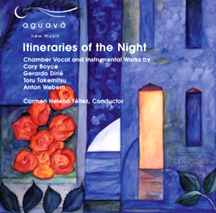
Image by Margaret Dolinsky
I went to the dress rehearsal of PASSION with Tropes by composer Don Freund, a multi-media meditation on the Passion of Christ. The production is an artistic collaboration with choreographer Elizabeth Shea, digital artist Margaret Dolinsky, lighting artist Robert Shakespeare, video producer Susanne Schwibs, and a chamber orchestra/jazz and rock band with singers from the Indiana University Contemporary Vocal Ensemble conducted by Carmen Helena Tellez, who also conceived and produced it. PASSION with Tropes is a superb production with great singing and playing, fine acting and dancing, and an excellent balance of forces all around. And the words come across in a surprisingly clear fashion, and even the St. Charles School Children’s Choir makes a musically exceptional appearance.
The music and concepts come across (to me, at least) as brief, vaguely related vignettes, a stream of consciousness for about 80 minutes. I loved the space, much like a black box. The audience is placed on-stage in four corners, with and within the action. Sometimes ones attention is split in trying to take it all in. Margaret Dolinsky’s images, projected on the sides of the space are mildly dynamic and quite brilliant, reminiscent of the playfulness of Marc Chagall and Gustav Klimt but with somewhat interactive elements. The dancing was both athletic and tender at the same time, nicely incorporated into the acting surrounded by the images and music, and it’s all pulling for simultaneous attention.
Freund assembled the “narrative” from the works of a plethora of poets, playwrights, and philosophers, covering a lot of ground ranging from ancient passages to contemporary beat. These are delivered via actors and/or singers, often cached in the music itself, which further fractures the their perspectives and diverse philosophical and stylistic points of view (hence the “tropes” aspect). The work incorporates plainsong tunes, quotes from Bach’s Violin Sonata in A Major (nicely played, though I didn’t have a program for the name of the soloist) with poems read across the surface, jazz riffs ala Bernstein, and gasps bounced from Scottish composer James MacMillan’s Seven Last Words from the Cross (Eli, Eli, lama sabachthani?—My God, why have you forsaken me?) in the “Cry” sections that act as a structural ritornello. There were wonderfully sung and played Jazz riffs ala Bernstein, and the propulsive shifting meters and colorful orchestration that tend to be Freund at his most characteristic–if he can actually be nailed down in such a way (please pardon the pun).
I wasn’t sure whether the stance was pro-spiritual or anti-Christian, or if the push and pull is really the point of it. Freund’s music and this multi-faceted concept in particular tend to be all over the stylistic map anyway, due to a great virtuosity of musicianship and imagination. In its entirety, this is a highly engaging work, quite literally immersing the audience in the ride, and an exceptional production in the very multi-layered aspects of it. Even presented as an oratorio of sorts, it’s difficult to describe exactly “what” it is, as it encompasses so many elements. But this is the point, I think.
More information at http://donfreund.com/?page_id=58 and http://indianapublicmedia.org/arts/passion-tropes/





Leave a Reply